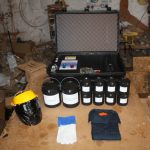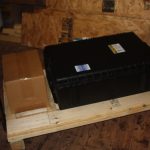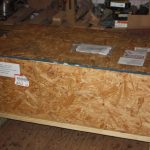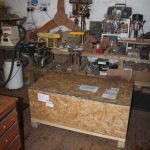Introducing our new UV lacquer system
The future ? It’s here at Bailey Guitars!
The crate turned up a while ago and we have been working hard ever since perfecting our technique. It has not been easy and there have been a few pitfalls along the way but the results we are getting now are truly spectacular. I will write a full list of ‘UV’ instructions in a future blog but first I wanted to explain a few things:
Why use UV lacquer?
Conventional lacquer needs time to dry- it contains solvents and these need time to evaporate leaving behind the hard shiny finish which is then flatted and polished to the mirror like surface we are used to seeing on guitars. The problem is it takes so long!
A cellulose finish takes up to 3 months curing time- even then solvents will continue to evaporate causing the lacquer to ‘sink’ into the grain of the wood. At the same time it will be getting thinner and become more brittle, eventually wearing off completely. Look at any really old guitar and you will see what I mean. This is fine for musical instruments, and part of the reason why old guitars sound ‘better’ than new ones, so we will continue to offer a cellulose finish for those traditionalists who are prepared to wait.
There are many alternatives to cellulose for example ‘two pack’ lacquer which dries by a chemical process – a catalyst or hardener is added to the lacquer hence the name. These do dry faster but tend to be thicker and still suffer from sinkage over time.
Our new UV Cure system has many advantages:
UV lacquer can be sprayed brushed or wiped on and is dried or ‘cured’ in minutes with UV light. It still needs flatting and polishing, so roughly the same amount of work goes into each spray job, but:
- It’s faster- there is virtually no drying time so this speeds up the finishing process dramatically.
- It’s thinner- this is great for musical instruments. Thick coatings can dull the sound of a guitar so the thinner it is the better.
- It’s harder- more scratch resistant and durable than other conventional finishes. It is also impervious to chemicals like alcohols and solvents and even itself once dry.
- It’s ‘greener’- better for the environment (and for us). There are no solvents- that’s zero VOC content.
- No sinkage- It won’t sink into the grain because there are no solvents to evaporate- when it’s dry, it’s dry!
Tomorrow never knows…
Our first UV guitar will be assembled tomorrow – Manuel’s. Billy polished it today and it is looking fantastic. I will post pics of the finished guitar ASAP…Looking forward to hearing what you all think.




